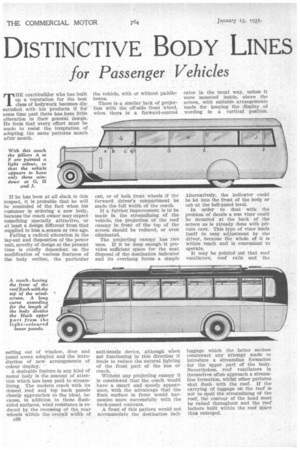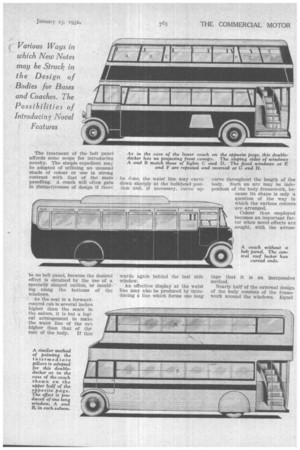DISTINCTIVE BODY LINES
Page 60

Page 61

Page 62

If you've noticed an error in this article please click here to report it so we can fix it.
for Passenger Vehicles
THE coachbuilder who has built up a reputation for the best class of bodywork becomes dissatisfied with his products if for some time past there has been little alteration in their general design. He feels that every effort must be made to resist the temptation of adopting the same patterns month
after month.
If he has been at all slack in this respect, it is probable that he will be reminded of the fact when his customer is ordering a new body, because the coach owner may expect something specially attractive, or at least a design different from that supplied to him asseason or two ago.
Failing a radical alteration in the lay-out and disposition of the power unit, novelty of design at the present time is chiefly dependent on the modification of various features of the body outline, the particular setting out of window, door and panel areas adopted and the introduction of new arrangements of colour display.
A desirable feature in any kind of motor body Is the amount of attention which has been paid to streamlining. The modern coach with its domed roof and top back panels closely approaches to the ideal, because, in addition to these flushsided surfaces, wind resistance is reduced by the recessing of the, rear wheels within the overall width of
c38 the vehicle, with or without paddleboxes.
There is a similar lack of projec'Wm with the off-side front wheel, when there is a forward-control
cab, or of both front wheels if the forward driver's compartment be made the full width of the coach.
If a further improvement is to be made in the streamlining of the vehicle, the projection of the roof canopy in front of the top of the screen Should be reduced, or even eliminated.
The projecting canopy has two uses. If it be deep enough it provides sufficient space for the neat disposal of the destination indicator and its overhang forms a simple anti-dazzle device, although when not functioning in this direction it tends to reduce the natural lighting of the front part of the bus or coach.
Without any projecting canopy it is considered that the coach would have a smart and speedy appearance, with the advantage that the flush surface in front would harmonize more successfully with the back-panel contours.
A front of this pattern would not accommodate the destination indi cator in the usual way, unless it were mounted inside, above the screen, with suitable arrangements made for keeping the display of wording in a vertical position.
Alternatively, the indicator could be let into the front of the body or cab at the belt-panel level.
In order to deal with the problem of dazzle a sun vizor could be mounted at the back of the screen as is already done with private cars. This type of vizor lends itself to easy adjustment by the driver, because the whole of it is within reach and is convenient to operate.
It may be pointed out that roof ventilators, roof rails and the luggage which the latter enclose counteract any attempt made to introduce a streamline formation for the upper part of the body. Nevertheless, roof ventilators in themselves often approach a streamline formation, whilst other patterns shut flush with the roof. If the carrying of luggage on the roof is not to spoil the streamlining of the roof, the contour of the head must be raised throughout and the roof lockers built within the roof space thus enlarged.
The treatment of the belt panel affords some scope for introducing novelty. The simple expedient may be adopted of utilizing an unusual shade of colour or one in strong contrast with that of the main panelling. A coach will often gain In distinctiveness of design if there.
be no belt panel, because the desired effect is obtained by the use of a Specially shaped outline, or moulding along the bottoms of the windows.
As the seat in a forward control cab is several inches higher than the seats in the saloon, it is but a logical arrangement to make the waist line of the cab higher than that of the rest of the body. If this
be done, the waist line may curve down sharply at the bulkhead position and, if necessary, curve up
wards again behind the last side window.
An effective display at the waist line may also be produced by introducing a line which forms one long curve throughout the length of the body. Such an arc may be independent of the body framework, because its shape is only a question of the way in which the various colours: are arranged.
Colour thus employed becomes an important factor when novel effects are sought, with the advan
tage that it is an inexpensive method.
Nearly half of the external design of the body consists of the frame. work around the windows. Equal ized lights are desirable from the iaintenance point of view, and may people consider that a regular pacing of the side pillars gives the 'us or coach a neat and workmanike appearance. Too many small vindows tend to impoverish the lesign, whilst.a maximum width of vindow lends impressiveness to the Thiele concerned and emphasizes ts length.
At the same time, a conventional ;etting-out of the window spaces nay be dealt with so as to give a 'resh effect if some of the internediate side pilars be painted a ighter colour :han are the Ahers. 'Ey this means the intermediate pillars are less clearly defined, with the result that the bus appears at first glance to have only a few extremely large windows. By developing this idea it is possible to give the illusion of one long window stretching the whole length of the saloon.
Any scheme that can be used for a single-deck bus may usually be applied also to a double-decker. The special shape, or decorative scheme, of the belt rail of a singledecker may be repeated for the corresponding part of the upper saloon of a double-decker. Alternatively, it may be varied by reversing the shape or colour arrangement, with a third design allotted to the cant-rail panel.
The side of a covered-top4doubledecker represents a particularly large surface. Usually the design consists of an upper and lower saloon having a similar arrangement of window and panel areas. Therefore emphasis tends to be laid on the fact that the hos has two saloons. It is suggested that there is scope for,novel exterior design if
this aspect be ignored and an attempt he made to re-design the whole of the side of the bus as one unit.
A movement in this direction is achieved if the front of the doubledecker ,forms a continuous sloping surface which will necessarily be more effective if the driver's compartment be of the full-width type. The prominent sloping line thus introduced may be repeated for some of the side pillars, so that two windows each at the front and rear of the upper saloon have parallel sloping sides.
Such windows may6be adjusted quite as easily as can the ordinary rectangular pattern. Then the sloping line may be used to form the ends of the main-panel divisions of one or both 'saloons, as well as for one or both sides of some of the lower-saloon windows.
The central-entrance doubledecker is a pattern .which has the advantage, from the artistic point of view, that the lower saloon has an aspect entirely different from that Of' the upper one. As the entrance will be wider than the usual size of window the opportunity may be taken for varying the lay-out of the side pillars of the upper saloon, so that some of them are not in the same vertical line as are those of the lower saloon.












































































































